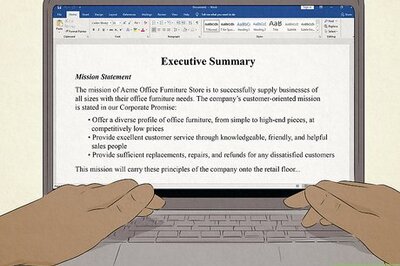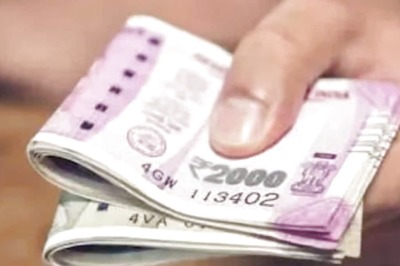
views
IT hardware industry body MAIT has asked the government to consider giving duty relief and export sops to boost the domestic electronic manufacturing sector.
MAIT, which represents the over $13 billion Indian IT hardware manufacturing industry, met the Prime Minister in January and following a meeting with PMO officials submitted its recommendations earlier this month.
Urging the Prime Minister to consider the recommendations, MAIT said it will continue to actively engage and jointly work with the government towards making 'Make In India' a success. Here are 6 key recommendations from MAIT for Budget 2015.
1. Extension of special additional duty (SAD) exemption to all ITA goods manufacturers
Issue:
Union Budget 2014-15 provided the much needed relief to domestic manufacturers of personal computers and tablets by addressing the issue of inverted duty structure suffered by the industry. However, only partial relief has been provided to the IT hardware manufacturing industry in limiting the exemption from levy of SAD to inputs/components used in the manufacture of personal computers (laptops / desktops) and tablet computers.
Thus, the instant benefit of SAD exemption does not extend to other ITA goods where the issue of inverted duty structure continues and is more pronounced.
Impact:
The impact of the inverted duty structure is such that it effectively makes direct import by end customers or trading (i.e, import and sale) of IT hardware/ ITA goods far more advantageous in comparison to manufacturing of these products in India; thus, making Indian manufactured goods uncompetitive for the domestic market.
Further, lack of clarity on the extension of the benefit of exemption upto the sub-component level has not completely mitigated the costs being incurred by a domestic manufacturer of personal computers and tablets.
Recommendations:
It is suggested that the benefit of SAD exemption may be extended to all goods (including inputs, components and accessories as well as their parts and sub parts) when imported for use in the manufacture of ITA goods. This suggestion, if implemented, should provide the necessary impetus to domestic hardware manufacturers by eliminating additional tax / duty costs incurred on account of an inverted duty structure.
2. Enhancement of abatement under maximum retail price (MRP) based excise valuation
Issue:
MRP based valuation was prescribed under central excise law with the intent to ensure revenue neutrality without increasing end user prices while reducing central excise valuation related disputes.
Since the time of introduction of MRP based valuation in respect of IT products in 2008, the percentage of abatement has been lowered from the initially prescribed percentage of 22.5 per cent to 20 per cent with no escalation in the quantum of abatement thereafter.
Pertinently, a key reason for the reduction in abatement percentage was linked to a reduction in the median rate of excise duty from 12.36 percent to 10.3 percent.
Impact:
While the total post manufacturing cost typically accounts for over 40 percent of the sale price, the abatement percentage prescribed at 20 percent is significantly lower than the costs incurred.
The overall industry expectation was that, with the increase in rate of excise duties and VAT, the percentage of abatement would correspondingly increase. However, the percentage of abatement prescribed has effectively reduced resulting in increase in cost at the hands of end customers.
Recommendations:
The rate of abatement on all IT products should be increased from 20 percent to 40 percent under Notification No 49/2008 - CE (NT)1 which prescribes the rate of abatement for products under MRP based excise valuation.
3. Deemed export benefits' in respect of information technology agreement (ITA) goods
Issue:
ITA bound goods (including their components when imported for use in manufacture of ITA goods) are exempted from the levy of basic customs duty ('BCD') when imported into India
A domestic manufacturer of ITA goods shall be liable to pay excise duty RAT 10.30 percent on the clearance of the manufactured goods to customers in India. In addition to the above, there is a levy of VAT / CST on the domestic sale of goods manufactured in India.
However, despite the numerous efforts of the Central Government, the IT hardware has failed to grow in India.
Recommendations:
It is recommend that 'deemed exports' status be provided to ITA bound goods in order to improve domestic hardware manufacture industry.
Deemed export status if granted shall ensure the following:
Zero rating of the supply of manufactured finished goods from excise duty levy perspective (excise duty exemption/ refund); and
Duty benefits (such as exemption / refund/ drawback) on inputs, components capital goods procured for use in the manufacture of such ITA goods.
Such duty benefit shall effectively reduce the tax burden on ITA goods and potentially encourage domestic manufacturing of the same.
4. Speedy disposal of Special Valuation Branch (SVB) cases
Issue:
Under the present provisions contained in the Customs Act, 1961 while there are procedures prescribed in respect of importing items / goods from related parties located abroad; such procedures are often time consuming and uncertainties prevail over the time frame for assessment and passing of orders by the SVB authorities.
Impact:
Especially delays in renewing the SVB order even when where there is no change in fact pattern has been causing severe hardship to companies delaying imports and enhancing transaction costs.
Further, insistence on SVB even where the goods attract nil rate of basic customs duty / are subject to MRP based CVD levy (such as majority of ITA goods) is causing severe hardship to the business.
Recommendations:
In view of the above, it is recommended that a definitive time frame should be provided in the Customs Act for issuance of an SVB valuation order.
While in certain cases, due to the complexity of the matter involved, it may be difficult to issue an order within the time prescribed, suitable guidelines can be placed such as obtaining approval from the higher authorities (Commissioner / Chief Commissioner) for taking additional time to dispose the application in such cases.
This would ensure that there would are no laches on part of the department/ field level officers in disposing off the SVB references.
Specifically a short time-frame ought to be fixed for issuance of renewal orders with a shorter and well defined time-frame for renewal of SVB orders where there is no change in fact pattern.
Further, SVB proceedings should be relaxed or atleast fast tracked with respect to goods that attract nil basic customs duty and MRP based CVD assessment.
5. Prescription of higher rate of depreciation
Issue:
We wish to highlight that in the absence of definition of the term 'computer and computer peripherals', significant number of ITA products do not enjoy the accelerated rate of depreciation. It is important to note that all ITA products have approximately the same life cycle as 'computers and computer peripherals'.
Impact:
The rate of depreciation prescribed in respect of capital goods (other than computer and computer peripherals) is very low. For these products (under the prescribed depreciation for capital goods) to achieve full depreciation, it takes more than five years.
This result in a host of IT products whose effective life is exhausted within a few years (on par with computers and computer peripherals) being considered for lower depreciation and consequently for higher tax reversals / payment at the stage of their de-bonding / disposal thereby enhancing costs incurred by businesses.
Recommendations:
In view of the above issue, it is recommended that a definition of the term 'computer and computer peripherals' be inserted in the CENVAT Rules to include all ITA bound products inter alia specifically including network and testing equipments.
This amendment would ensure that all ITA bound products enjoy an accelerated depreciation rate in comparison to the depreciation rate prescribed in respect of capital goods.
6. Introduction of Goods and Service Tax (GST) legislation may be expedited
Issue:
The Government of India has been contemplating introduction of GST for some time now, as expected, the GST regime will revamp the entire indirect taxes in India and would require significant changes to be undertaken by the companies from financial, infrastructure perspective.
However, without any substantial progress being made on this front by the Government, apprehending any semblance of the GST regime is far-fetched. Given the significant impact of GST on the businesses and target for interdiction of GST being April 2016, it is imperative for the Government to engage vigouroulsy with the industry.
Impact:
Lack of vigour introduction of GST on part of the Government and absence of dialogue with the industry may hamper the successful implementation of GST.
Recommendations:
It is recommended that Central Government should come out with the draft GST legislation at the earliest for the purpose of understanding, discussions and eliciting the views of the business and trade.
Business community should be provided sufficient time to understand and study the legislation and its implications on the business and trade and to contribute with the views and suggestions.
The views and suggestions made by the business and trade community can thus be suitably accommodated, clarified, taken into account at the time of introduction of formal GST legislation.



















Comments
0 comment